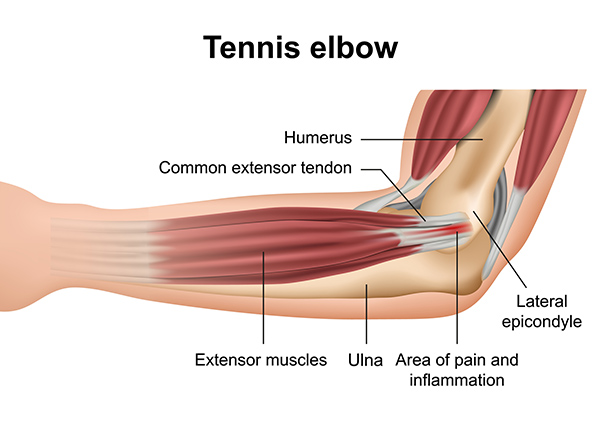
One of the most common upper extremity overuse problems is lateral epicondylitis (LE), more commonly referred to as tennis elbow. Despite its common name, only about five percent of the people with LE developed the condition from playing tennis.1
The dramatic increase of repetitive motions in numerous jobs has led to a surge of tennis elbow over the last several decades. And there are heavy socioeconomic burdens because of it: lost productivity for employers, lost or diminished wages for employees, long periods of pain, and significant workers’ compensation claims.
Massage is one way to tackle this common, frustrating problem.
What is Tennis Elbow?
Tennis elbow is most commonly associated with repetitive overuse actions of the wrist extensor muscles. These actions could include repetitive or forceful wrist extension, long periods of gripping objects, or movements that include forearm supination or radial deviation. Repetitive eccentric loading on the wrist extensors is also a primary cause. What does this mean? A repetitive eccentric load would be one where your wrist extensors are trying to prevent your wrist from moving into flexion while slowly resisting that motion. Imagine curling a dumbbell with only your wrist.
In addition to repetitive motion, long periods of contraction of the wrist extensors may also lead to LE. For example, grasping tools or implements during work activities might not involve repetitive motion as much as constant contraction to hold the implement in a certain position. Computer users who spend much time operating a mouse develop epicondylitis for this reason. It’s not so much about the repetition of movement of the wrist as much as the wrist extensors and flexors are both in a chronic state of tension when holding and manipulating the mouse.
Other factors play a role in developing epicondylitis. Body mass index, history of rotator cuff disease, de Quervain’s tenosynovitis, carpal tunnel syndrome, and a history of smoking are all correlated with a higher incidence of tennis elbow. It may be that some of these factors developed from the same mechanical stressors and just happened to occur simultaneously.

Like most chronic overuse tendon disorders, tennis elbow is not an inflammatory condition caused by fiber tearing. Instead, the primary dysfunction appears to be collagen degeneration within the tendon.2 We have a better understanding of the actual physiology of tendon breakdown in these conditions now, but we still don’t have a good understanding of why the collagen degeneration occurs.
There may still be some minor inflammatory activity at certain stages of the problem. However, framing the condition as one of fiber tearing and inflammation encourages a problematic treatment strategy. One of the primary treatment methods for reducing inflammation in soft tissues is corticosteroid injections. Unfortunately, corticosteroids have detrimental effects on long-term collagen synthesis within soft tissues and are a known factor in tendon weakening. The corticosteroid injections are effective at pain relief, which gives them the impression of healing the condition, but are detrimental in the long run.
Massage For Relief
So what role does massage play in epicondylitis treatment? One of the most commonly used massage treatment strategies is deep transverse friction (DTF). Originally it was thought that the primary benefit of DTF was helping to realign scar tissue from the torn tendon fibers. However, that idea has now fallen out of favor as it has become clear that torn tendon fibers rarely play a role in epicondylitis. It could be that pressure and movement on the impaired extensor tendons could be encouraging rebuilding of the damaged collagen structure within the tendon.
Another possibility is that the key benefits of friction massage are not only mechanical (pressure and movement), but also help in pain reduction through neurological processes.
Reducing hypertonicity is another important role that massage can play in treating epicondylitis. Applications that appear particularly effective are compressive warming strokes and broad sweeping cross-fiber strokes. As treatment progresses, deeper longitudinal stripping methods are very effective, and active engagement lengthening techniques appear to bring good results as well. Engaging the muscle in an eccentric contraction involves greater neurological input along with the massage technique. This greater neurological input may serve to enhance a pain-reducing process called descending modulation. We know this treatment is particularly effective.
Lateral epicondylitis can become a debilitating condition, and because it is often related to occupational injuries, the condition can provoke significant anxiety. When caught early, activity modification and reduction of the mechanical load can halt the progression of the condition. If it has progressed further, massage is an ideal intervention for enhancing physiological change, as well as managing psychological and social impacts of this common malady.
Notes
1. Wilson C. Lai et al., “Chronic Lateral Epicondylitis: Challenges and Solutions,” Open Access Journal of Sports Medicine 9 (October 2018): 243–51, https://doi.org/10.2147/Oajsm.S160974.
2. Evelyn Bass, “Tendinopathy: Why the Difference Between Tendinitis and Tendinosis Matters,” International Journal of Therapeutic Massage and Bodywork 5, no. 1 (March 2012): 14–17.
Treatments
The most common strategies employed for tennis elbow include physical therapy, nonsteroidal anti-inflammatory drugs (NSAID), shockwave therapy, kinesiology taping, biologics, corticosteroid injections, and massage.
Biologics—A general term used to refer to several new treatment techniques, such as autologous blood transfusion (the collection of blood from the patient and re-transfusion of that same blood back into the patient).
Platelet-rich plasma (PRP) injection therapy—PRP injections use a method where platelets, which play a major role in tissue repair, are extracted from the individual and reinjected to stimulate tissue repair processes.
Corticosteroid injections—It is surprising that corticosteroid injections are still used as a treatment strategy even though their potential danger and damage of tendon tissue has been well documented for decades. They aren’t used anywhere near as often as they used to be, but they are still used in some cases.
Whitney Lowe is the developer and instructor of orthopedic massage training programs. His text and programs have been used by professionals and schools for almost 30 years. Learn more at www.academyofclinicalmassage.com.



